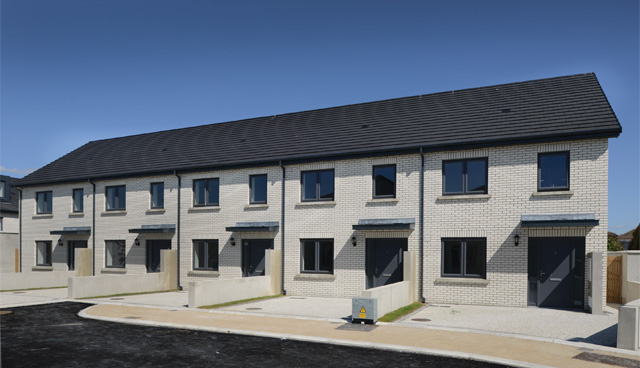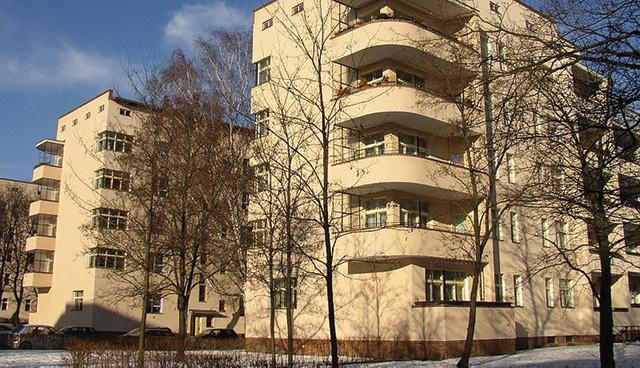
Oaklee Housing: Looking to the future
21st July 2020
A decade in review
21st July 2020Comparison: What can be achieved by local government

Local authority housing provision is an area of vast opportunity in responding to Ireland’s housing crisis. The Housing Magazine surveys international examples of what has been achieved at the local level across social housing provision, land use initiatives and rent control measures.
Salford
In England, October 2019 saw Salford City Council hand over the keys to the first homes owned by its housing arm, Dérive. Dérive had purchased homes in the Riverbank View development in the Charlestown area of Salford, where 86 of the 430 homes were classified as affordable. The council-owned homes in the development are split evenly between affordable and socially rented.
‘Affordable’ is defined as “rent capped at the local housing allowance” meaning that “if a family are on housing benefit, they will still be able to live in these homes that are classed as affordable rent”. Socially rented homes within the development are priced at £89.94 per week for two-bedroom properties and £100.27 per week for three bedrooms. Affordable two beds are priced at £122.58 per week, with three-bedroom properties prices at £137 per week. In comparison, the housing website home.co.uk reports that the average rent for two bedrooms in Salford is £1,060 per month, with a median of £975 per month, and three-bedroom properties average at £1,363 per month, with a median of £1,170.
Dérive was founded in 2017 by the Salford City Council as a wholly owned subsidiary using £2 million of what is known as Section 106 money in England. A Section 106 agreement is an agreement between a planning permission applicant and the local planning authority whereby the impact of a new build on communities and local infrastructure is mitigated, typically in the form of a financial contribution. Speaking at the time of the launch of the Riverbank View homes, Salford Councillor John Merry said that the Council “had to do this in the absence of any government support so we could meet the needs of local people”.
Salford is experiencing its own housing crisis, with over 6,000 people on its housing lists, 52 bids on every home advertised (as of October 2019) and an estimated shortfall of 613 affordable homes per year. This has led to a multi-pronged approach which has seen the Council also reintroduce truly council-managed housing alongside the Dérive stock. Having had almost 20,000 council homes in the 1960s and ‘70s, the last of the area’s public housing was transferred to Salix Homes (who manage the Dérive stock on the Council’s behalf) and the City West housing association in 2014.
However, a £7.7 million grant from Homes England has allowed the Council to pursue the construction of new builds on vacant council land. The properties are expected to be ready in 2021 and will come in a range of between one and four bedrooms, with one-bedroom properties to rent starting at £74 per week.
New South Wales
Local governments in Australia have typically had a limited role in housing policy, having been largely relegated to land use planning for the facilitation of private development, with the federal government handling the provision of social housing. Recent reforms have focused on an effort to improve strategic land use and pair it with long-term regional strategic plans.
Many councils in the state of New South Wales (NSW) have completed their Local Housing Strategy as part of these strategic plans. When the NSW Government released its Greater Sydney Region Plan in 2018, local authorities in Sydney’s metropolitan area were required to prepare a Local Housing Strategy. NSW’s Department of Planning, Industry and Environment issued guidelines that advised local governments to include social and affordable housing policy and to include a housing component in their economic development strategies.
Responses have been varied, with City of Canada Bay outlining in detail where developments would be built within its locale and the planning control changes needed to adapt to the strategy, while other councils such as Inner West Council have identified types of developments and reforms needed without the concrete recommendations of Canada Bay.
The types of plans outlined by the City of Canada Bay Council are notable steps forward in the provision of social housing in NSW, where previously the federal government had been in charge with little planning involved at the local level. Instead of simply focusing on land use to open space for development to occur, the Council is now playing a role in pinpointing when development should happen, where it should happen and what type of development should be constructed. Using this framework, Canada Bay has set targets of 43,700 new dwellings by 2026 (a growth of 5,600 homes from 2018 to 2026 or 3,800 from 2021 to 2026) and 52,400 by 2036. The Council says that its five-year target (starting in 2018) has “effectively already been met”.
Berlin
Rent freezes and controls are of particular interest in Ireland, where rents have been successively reaching record levels in recent years. Berlin is often noted as an international example of what can be done to achieve a rent freeze and rent controls due to recent measures taken by its House of Representatives to tackle the rental crisis ballooning in the city.
Introduced in January, Berlin’s rent freeze is time capped, similar to the Sinn Féin Bill that passed the first stage of a Dáil vote in December 2019 prior to the dissolution of the Dáil, and is estimated to impact about 1.5 million homes by putting a cap of €9.80 per square metre on rents. Two unique elements of the law are that landlords now cannot charge a rent higher than what the previous tenant paid and if rents charged exceed the limits in the “rent table”, a tenant can sue in order to have their rent lowered.

Wohnstadt Carl Legien housing estate in Berlin.
The Berlin rent freeze is not a complete freeze; in order to encourage continued construction, buildings built after 2014 were exempted from the measures and from 2022 onwards, landlords will be permitted to raise rents in line with inflation of 1.3 per cent per year. Berlin, despite being heralded as a unique example worldwide, does seem to have simply caught up with similar rent control initiatives already present in places like New York, Vienna and Barcelona.
After the rent freeze came into force in February, a Berlin district court ruled it to be unconstitutional in March, referring it to Germany’s Federal Court of Justice (supreme court). Despite the fact that landlords have already failed in challenging the law’s fine mechanisms at the federal level, the district court ruled that it does not believe the House of Representatives to have the power to institute such a law. The case is currently waiting to be examined, but as an example of what can achieved and the strength of opposition to such a measure, it remains one of particular interest in Ireland.





